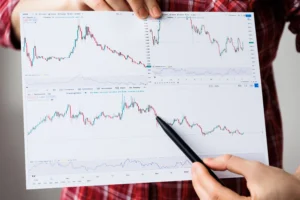For most everyday traders, finding an edge in the markets comes down to timing. Chasing every move can feel exhausting and random. But what if you could spot a reliable “pause” in a trend and confidently join in just before the next big wave? That is the power of the continuation pattern.
A continuation pattern signals that a market trend is simply resting, not reversing. These price formations allow you to enter with clear rules, defined risk, and the wind of momentum at your back. By understanding continuation chart patterns and blending them with proven trend trading techniques, even casual traders can turn chaotic price action into opportunity.
This guide will give you an in-depth, step-by-step look at the continuation pattern—how it works, why it’s so powerful, the main types, the logic behind their success, and how to trade them with real-world strategies. You will see exactly how flag and pennant patterns, rectangles, and triangles form in live markets. You will get practical trading continuation strategies, examples from forex, stocks, crypto, and commodities, and advanced tips for spotting the highest-probability setups. Let’s begin your journey toward trading trends with clarity and consistency.
What Is a Continuation Pattern?
A continuation pattern is a chart formation that develops in the midst of an existing trend. Rather than signalling a reversal or exhaustion, this pattern indicates that the current direction—up or down—will likely resume after a short period of consolidation or sideways movement.
In simple terms, the continuation pattern is a market “pit stop.” The trend pauses, but underlying momentum stays alive. When the pattern completes, price often bursts out in the original direction, letting traders catch the move with less risk.
Continuation chart patterns appear in every liquid market: stocks, forex, commodities, and crypto. They’re so popular because they help traders avoid the temptation of predicting tops or bottoms. Instead, you join the trend, let the market rest, and enter when a breakout confirms the move is ready to continue.
Some classic types of continuation patterns include flag and pennant patterns, rectangles, and triangles. Each has its own shape and trading approach, but all signal that the trend will probably carry on.
Why Continuation Patterns Matter for Traders
Many traders fall into the trap of chasing price after a big move or, even worse, betting against a strong trend hoping for a reversal. This is risky and often leads to losses. The continuation pattern helps you avoid these errors by showing exactly where the market is taking a breather and preparing for the next run.
By waiting for a continuation pattern, you unlock several key advantages:
- You avoid emotional decisions. You do not jump in too soon or too late.
- You use the pattern’s structure to set clear entries, stops, and profit targets.
- You join the trend at logical points, instead of after the “easy” part of the move.
- You increase your consistency by trading with, not against, the market’s direction.
- You can apply trend trading techniques for even more confidence and clarity.
Combining these benefits, everyday traders who learn to recognise continuation chart patterns are less likely to get shaken out by random volatility or news. They ride trends longer, avoid overtrading, and make smarter, more systematic decisions.
Types of Continuation Chart Patterns
There are several major continuation patterns that show up across different markets. Learning to spot these can add structure to your trading and boost your results.
Flag Patterns
Flag patterns are common in trending markets. They start with a sharp move called the “flagpole,” followed by a small, rectangular channel that slopes against the trend. If the trend is up, the flag slopes slightly down or sideways. When the price breaks out of the flag in the direction of the main trend, it’s a signal that the trend is ready to continue. Many traders set their profit targets by measuring the flagpole’s height and projecting it from the breakout point.
Pennant Patterns
Pennant patterns look like tiny symmetrical triangles. They form after a rapid price move, with the market contracting into a narrow range. Pennants last for a short period and usually resolve with a breakout in the original trend’s direction. The logic is simple: buyers and sellers pause to catch their breath, then the dominant group pushes the price onwards. Pennant and flag patterns are sometimes discussed together, as they often signal similar opportunities.
Rectangle Patterns
When price moves sideways between two horizontal levels, you get a rectangle pattern. It’s like the market is on pause, with bulls and bears locked in a tug of war. Eventually, the price escapes the range, usually following the original trend. Rectangles offer traders clear entry and exit points. For example, in a strong uptrend, a breakout above the rectangle’s upper boundary suggests the next wave up is starting.
Triangles
Triangles are another important family of continuation chart patterns. Ascending triangles have rising support and a flat resistance line. They usually show up during bullish trends, hinting at further upside. Descending triangles are the opposite, often appearing in bearish markets with falling resistance and flat support. Symmetrical triangles show converging trendlines, and while breakouts can go either way, the prevailing trend usually wins out. These patterns require patience and careful timing, but they reward traders who wait for confirmation.
How to Identify Continuation Patterns
Spotting a continuation pattern begins with trend awareness. Only look for these setups when the market is clearly moving up or down. If the chart is choppy or directionless, ignore potential continuation chart patterns and wait for structure to appear.
Here’s a simple process to identify continuation patterns:
- Scan for a strong, existing trend.
- Watch for price to stall, trade sideways, or drift gently against the trend.
- Look for recognisable shapes: flag and pennant patterns, rectangles, or triangles.
- Draw boundaries using trendlines or support and resistance lines.
- Wait for volume to decline during the pause, then watch for a surge at breakout.
- Enter only after a decisive candle closes beyond the pattern’s boundary.
Key tips:
- The trend before the pattern should be obvious.
- The pause should not be too long; otherwise, it could signal exhaustion, not continuation.
- Always confirm breakouts with increased volume or momentum.
Example:
You are watching GBP/JPY, which rallies 300 pips in a single day. Price then forms a narrow rectangle, and volume falls. When GBP/JPY closes above the rectangle and volume spikes, this is your signal to enter with the trend.
Trading Continuation Strategies for Real Results
Once you’ve identified a valid continuation pattern, you need a trading plan that is simple, logical, and repeatable. Here are practical trading continuation strategies for each pattern type.
Flag and Pennant Pattern Strategy:
- Wait for a flag or pennant to form after a sharp price move.
- Draw trendlines to define the pattern’s upper and lower boundaries.
- Enter when the price breaks out in the direction of the main trend.
- Place your stop-loss just outside the pattern’s opposite side.
- Use the length of the flagpole or pennant’s base as your profit target.
Rectangle Pattern Strategy:
- Spot a clear rectangle in a trending market.
- Enter on a close above resistance (uptrend) or below support (downtrend).
- Set your stop-loss just inside the pattern’s boundary.
- Target a move equal to the height of the rectangle.
Triangle Pattern Strategy:
- Draw converging trendlines for the triangle.
- Wait for the price to break out in the original trend’s direction.
- Confirm with a volume or momentum surge.
- Set your stop inside the triangle.
- Target a move equal to the triangle’s widest point, projected from the breakout.
Advanced approach:
Blend these strategies with trend trading techniques. For example, enter only when the price is above a rising 50-period moving average. Use indicators like RSI or MACD for confirmation. Check higher timeframes for alignment. These simple rules will filter out lower-quality setups.
Practical Examples Using Continuation Patterns
Let’s see how these patterns play out in real markets.
Forex:
USD/JPY surges from 145.00 to 148.00 after a central bank statement. Price then consolidates in a flag for two days. When price breaks above the flag, traders enter long and ride the move to 150.00.
Stocks:
Apple climbs from $170 to $185, then trades in a rectangle between $182 and $185 for a week. A breakout above $185 signals the next wave, and the stock hits $190.
Crypto:
Ethereum jumps from $2,000 to $2,400, then forms a pennant. As price breaks out above the pennant, volume increases and ETH quickly rises to $2,700.
Commodities:
Crude oil moves from $70 to $78, forms an ascending triangle, and after a tight range, breaks out to $82.
These examples show that flag and pennant patterns, rectangles, and triangles are reliable across all markets and timeframes.
Mistakes to Avoid With Continuation Patterns
Success with continuation patterns relies on discipline and patience. One of the most frequent mistakes is entering a trade before the breakout is confirmed. If you jump in too early, you may get caught in a false move and lose capital needlessly. Always wait for a clear candle close beyond the pattern’s boundary, which signals genuine momentum.
Ignoring volume is another common error. Reliable breakouts are usually accompanied by a noticeable increase in trading volume. If the breakout happens on low volume, it often lacks conviction and may quickly reverse. Make volume analysis part of your confirmation process for every continuation pattern you trade.
It’s also important to remember that continuation chart patterns work best in trending markets. Trying to trade these patterns in sideways or choppy conditions often leads to frustration and poor results. Focus on setups that appear within clear, active trends.
Stop-loss placement can make or break your strategy. Placing stops too tight exposes your trade to normal price fluctuations, while stops that are too wide increase your risk. Ideally, position your stop just outside the structure of the pattern for balanced protection.
Finally, don’t treat every sideways move as a valid continuation pattern. Be selective. Look for clean, well-formed patterns that align with the prevailing trend. By sticking to these rules—waiting for confirmation, checking volume, trading in trending conditions, and using logical stops—you set yourself up for more consistent results and reduce costly mistakes.
Advanced Tips: Combining Continuation Patterns with Trend Trading Techniques
Enhancing your success with continuation patterns often means using them alongside trend trading techniques. The first step is to check for alignment across multiple timeframes. If you spot a bullish flag or pennant on an hourly chart, look at the four-hour and daily charts. The setup is stronger when all trends point in the same direction.
Using moving averages can also refine your trade selection. Patterns that form above a rising 50-period moving average in an uptrend—or below a falling average in a downtrend—offer better reliability. This simple check keeps you trading with the broader market flow.
Momentum indicators like RSI and MACD can provide an additional layer of confirmation. If a breakout happens while RSI is above 50 or MACD turns positive, the odds of a successful follow-through increase. These tools work especially well with flag and pennant patterns.
Pay attention to price action at the breakout. Candlestick signals—such as bullish engulfing candles or pin bars—show conviction from buyers or sellers and can make your entry more precise.
Location matters, too. Patterns that form near strong support or resistance, or at key volume zones, often result in more explosive moves. By blending continuation chart patterns with these trend trading techniques, you not only filter out weak signals but also position yourself for the highest-probability trades in any market environment.
Frequently Asked Questions
Q: How do I distinguish a continuation pattern from a reversal?
A: Continuation patterns form within existing trends and indicate that the trend will likely resume after a pause. In contrast, reversal patterns appear after long moves and suggest a possible change in direction.
Q: Do these patterns work in all asset classes?
A: Yes, continuation chart patterns are found in stocks, forex, cryptocurrencies, and commodities. They are widely used by traders in every market.
Q: What timeframe is best for trading continuation patterns?
A: Continuation patterns can appear on any timeframe. However, four-hour and daily charts often provide the most reliable signals for everyday traders.
Q: How often do flag and pennant patterns form?
A: Flag and pennant patterns are common in trending markets, especially following sharp price moves or significant news events. They are reliable tools for identifying trend continuation.
Q: Are trading continuation strategies suitable for beginners?
A: Absolutely. With practice, patience, and discipline, even beginners can effectively use continuation patterns as part of a straightforward and robust trading plan.
Why Every Trader Should Master the Continuation Pattern
A continuation pattern is not just a chart formation; it’s a proven method for trading with the trend, capturing bigger moves, and managing risk intelligently. By focusing on flag and pennant patterns, rectangles, and triangles—and blending them with trend trading techniques—you remove much of the guesswork and emotion from trading.
Whether you’re new or experienced, learning to spot, confirm, and trade these patterns can boost your results and your confidence. Practice identifying them, keep a journal of your trades, and always wait for confirmation before entering. With time, continuation chart patterns will become your go-to tool for finding low-risk, high-reward opportunities in any market.
Read here to learn more about “CFD vs Spread Betting: Top Differences and Tax Tips for 2025“.

I’m Chaitali Sethi — a seasoned financial writer and strategist specializing in Forex trading, market behavior, and trader psychology. With a deep understanding of global markets and economic trends, I simplify complex financial concepts into clear, actionable insights that empower traders at every level. Whether it’s dissecting winning strategies, breaking down market sentiment, or helping traders build the right mindset, my content bridges the gap between information and implementation.


